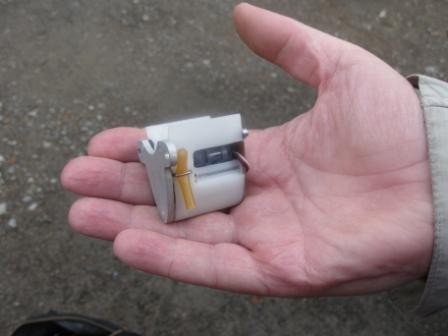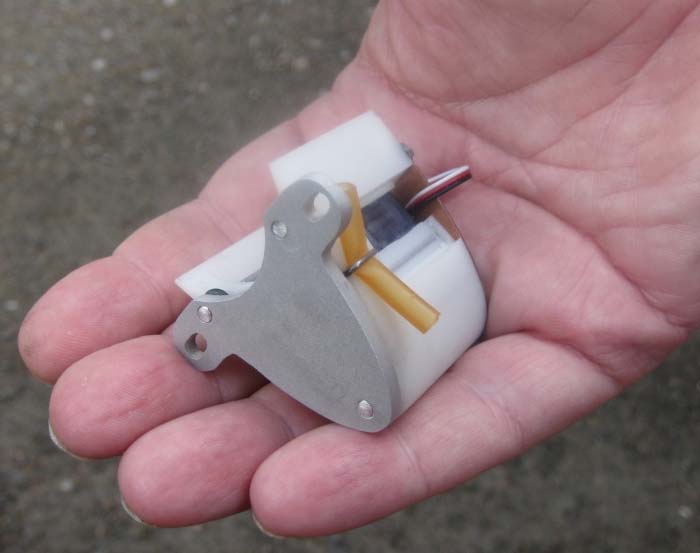Shut-off for F2D-Combat
Electronic shut-off by Göran Olson
|
Last update: 16/7 2009 Electronic shut-off with accelerometer and "normally closed" valve. Design by Göran Olson, Sweden
Göran is well known for his
CL homepage and the Transitracer.
|
 |
|
|
Göran Olsson, July, 15th. 2009:
Latest developments of my accelerometer-based eShut-off: Found 40 mAh LiPo batteries at 3 grams each on eBay. The shutoff needs two in series, and a diode to drop off some voltage as two LiPos deliver up to 8.4 V. The new power source solved the problem I had with the old Li-ion and Alkaline batteries, where the servo almost shorted the battery on start, and made the servo rattle. That they save 4 grams, are rechargeable and not too expensive ($6 each) is another advantage. Also, with this power source the servo becomes strong enough to pinch a standard 5 mm silicone tubing. The active parts now weigh 14 grams, but then I have a 16 gram holder out of delrin plus some alu, and here grams can be shaved off.
Made the first flight tests last Saturday. Unsuccessfully, as it shut off in normal flight.
Actually a good first try, as I learned it can actually shut off in real flight.
The acceleration threshold was set to 2.45 g, and the cut-off frequency to 5 Hz. This means a delay of about 0.022 s.
This was intentionally set far too fast, just to make sure it would shut off, but then it shut off from vibrations and shaking.
/Göran
Here is some photos of the prototype: The unit uses an accelerometer integrated circuit to sense the acceleration inwards in normal flight, and the loss of this acceleration when the lines are cut. (Accelerometer dimensions: 4 x 4 x 1 mm.) The acceleration inwards in normal flight is around 10 g, and could go down to around 2 g occasionally. If the lines are cut the acceleration is less than 2 g. A standard R/C microservo (mass=4.3 g) is used to operate a tube pincher. The unit is powered by a 6 V lithium battery d=13 mm, l=25 mm, mass=10 g. (Or four silver oxide button cells.) The battery is estimated to last a season. There are no external mechanical or electrical connections. The unit can be used also for the normal tube pinching during pitting. The electronics have these functional parts:
Two bistable elements:
The electronics assembly is made on a tiny printed circuit board, dimensions 14 x 23 mm, mass ~ 2 g. The board should be mounted horizontally with its long side aligned with the wing span. This must be done with good precision.
The prototype box I have prepared, seen in the picture, is designed to be attached to the engine bearers in front of the inner wing leading edge. Its support involves o-rings to dampen the engine vibrations. Other mechanical solutions are possible, such as mounting the components in a box inside the wing.
I do not intend to produce a complete unit, just the circuit board. The first prototype I hope to have ready for demonstration at the Karlskoga World Cup competition on 6th June.
I could have a first series of boards available later in the summer. The servo costs 12 Euros, the battery 6 Euros. If someone else makes a box to hold the components, including the tube pincher mechanism, what could the cost be? A very rough guess is 30 Euros. Drawback: The servo is not strong enough to pinch the silicone or neoprene type of fuel tubing normally used, with the simple mechanism I made. Maybe a better design can be developed. On the prototype I use a small size latex tubing, which must be used for the portion of the fuel tube that runs through the pincher. A heavier servo is another solution. The electronics will accomodate any standard R/C servo. /Göran Olsson, May 2009  Wikipedia: Accelerometer |
||
--= Back 1 2 3 4 5 6 7 8 9 10 11 12 13 14 15 16 17 18 19 20 21 22 23 24 25 26 27 28 29 30 31 32 33 34 35 36 37 38 39 40 41 42 43 44 45 46 47 48 49 50 Next =--
Shut-off start - F2D.dk
